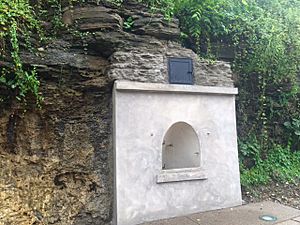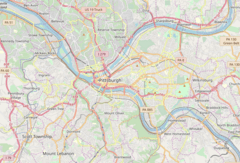Voegtly Spring facts for kids
 |
|
| Location | Damas Street (Spring Hill (Pittsburgh)), Pittsburgh, Pennsylvania, [[United States |USA]] |
|---|---|
| Coordinates | 40°27′56.46″N 79°59′28.22″W / 40.4656833°N 79.9911722°W |
| Area | Spring Hill |
| Built/founded | 1912 |
| Governing body/ |
City of Pittsburgh |
The Voegtly Spring is a historic water source found on Damas Street. It is located in the Spring Hill neighborhood of Pittsburgh, Pennsylvania. The building around the spring was built around 1912. It shows a simple, local building style known as Vernacular architecture.
Contents
A Look Back: History of the Spring
The land where the spring sits was bought by the Voegtly family in 1864. They bought it from William Robinson Jr., who was the first mayor of Allegheny City. The Voegtly family and their relatives owned this land for many years.
The spring was passed down through the family. John Voegtly, who had no children, left the spring's land to his sister, Sarah V. Crone. After Sarah passed away in the 1930s, the land was meant to go to two charities. However, these charities had changed. So, the family made a deal to get the land back. The spring stayed with the Voegtly family until the City of Pittsburgh bought it.
The Voegtly family was important for the spring. They guided the water and kept the spring working. They even opened it for everyone to use for almost 50 years. Maps from 1882 already showed a stream flowing down Spring Hill.
How the Spring House Was Built
Even though the Voegtly family owned the land, the City of Pittsburgh built the structure around the spring. People in the community asked the City for help. In 1912, the City asked the Voegtly family for permission to build a permanent catch basin for the spring. The family agreed.
The spring was a very important water source for the community. The Spring Hill neighborhood is on a hill. This made it hard for homes at the top to get water. Natural springs, like Voegtly Spring, were very helpful. This is actually how the neighborhood got its name!
The Spring During the Great Flood
The spring was especially valuable during the 1936 "St. Patrick’s Day Flood." This flood caused a lot of damage to the city's water supply. Drinking water became hard to find. During this time, local businesses, hospitals, and people used the springs for their water.
Voegtly Spring kept working until the early 1950s. But then, new houses were built above the spring. This caused the water to become dirty. By the late 1950s, the spring was closed off with cement.
Reopening and Recognition
The spring stayed closed until mid-2016. City officials then fixed it up and reopened it for people to drink from. In January 2016, Preservation Pittsburgh suggested that the spring become a City Historic Landmark. This would help protect its history.
Building Style: Architecture of the Spring
The structure around the Voegtly Spring was built in the vernacular architectural style. This means it was built using local materials and skills. It was not designed by a trained architect. Instead, local builders used their own knowledge.
For example, the bottom part of the spring's structure is made of concrete. The top part uses a mix of cement and rocks from the nearby hillside. Voegtly Spring is special because it's the only remaining spring in Pittsburgh that doesn't follow a specific design style.
Gallery




